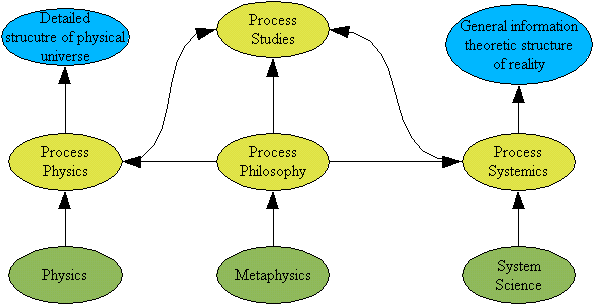
Process Oriented System Modeling or Process Systemics
Related discussions:
Overview of this work
Metaphysical Context
Related: metaphysical ideas in other people's work.
My work has had an inherently process oriented core throughout but I have only recently explicitly recognised that as something different from much of the rest of science. I have essentially developed a parallel and complementary form of process philosophy, process metaphysics and process systemics.
See the metaphysical overview (especially System Theoretic Metaphysics) to better understand the overall context of this discussion. Also see a brief history for more background on the evolution of my process oriented ideas.
I have been working from a process oriented approach all along and have developed a form of process oriented system science. Starting from the same foundational concepts I have developed a form of process philosophy and extended it in a novel direction. I have yet to properly explore all the parallels between the established field of process philosophy and my own work but there is considerable alignment, and similarly for process physics.
I give a brief overview of the process approach in the brief summaries of process philosophy and process physics, and there is some broader contextual information in the analysis of the Theoretic Context of SMN / IST.
Process philosophy provides a natural conceptual foundation to my work and process physics may help to fill major explanatory gaps, such as the details of how, in the metaphysical case, the underlying computational process produces the spatial-objective context and how patterns arise and form into systems within a universe with physical properties such as we have. I have explored this in the general case which is useful for general system modeling and engineering purposes but the full metaphysical case is far from solved.
For information on the details of SMN see these related discussions.
In the document SMN and System Theory I map out the parallels between SMN and system theory and show that the mathematics of SMN naturally gives rise to the logic of system theory. This logic then guides the construction and evolution of all manifest systems, it is this that the world is "made of"; i.e. dynamical information/computation harnessed within a system theoretic idiom or reality-constructive modeling language. This has aspects in common with the work of C.M. Langan on the “Cognitive Theoretic Model of the Unviverse” (CTMU). Where the systemic idiom is equivalent to the virtual-reality-generative grammar. This parallel has become much clearer due to the algorthmic refinement of the software implementation of the mathematics of SMN. The program has conceptually evolved into a self-configuring self-processing language (SCSPL) operating on a self-excited circuit. See Logical Equivalence for more information, this discussion covers the basic algorithmic processes that underly SMN and it also leads on to a description of the full non-ergodic SMN algorithm. This allows for complete flexibility within the empirical context. Both the structure and behaviour of systems are able to dynamically evolve.
In the metaphysical enquiry SMN describes the underlying mechanics of reality; whilst leaving room for empirical details to be filled in it maps out the general information theoretic and system theoretic properties of reality. As well as its role in the metaphysical enquiry SMN is also a practical computational tool. SMN is an inherently process oriented and information theoretic modeling paradigm and this combines with the system theory and software implementation to give rise to a dynamical system theoretic, existential context that can be used to simulate, model, analyse, design and engineer systems of many kinds. It is a modeling paradigm that captures the principle known aspects of reality, from the inner causal dynamics and outer observable behaviour, to the system theoretic construction of manifest forms, to the experience of the present moment of time and to the experience of “being in a world”. It models time as an iterative dynamical process rather than as an abstract dimension, and systems are patterns of information that flow through a causal network that produces the changing states and thereby manifests the simulated dynamics.
SMN is a coherent system modeling paradigm, it manifests within its mathematical modeling space a process oriented metaphysical context with system theoretic properties, thus the software implementation creates metaphysically coherent existential spaces wherein systems may exist and interact. It is essentially an application of metaphysics, ancient wisdom, process studies and computational science to the fields of system science, system engineering, system modeling and system analysis.

This work forms part of a paradigm shift that is occurring, a shift to a more information theoretic understanding of reality. Process philosophy and system science are a natural part of that emerging paradigm.